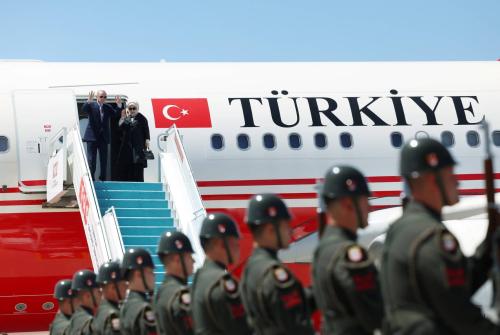When NATO leaders gather in Warsaw on July 8 to 9, they will announce steps to beef up the alliance’s conventional force presence on its eastern flank. NATO also will shortly announce that the SM-3 missile defense site in Romania has achieved operational status. These moves will spur the Kremlin, with some fanfare, to announce military “countermeasures.” But those will be steps that Moscow almost certainly intends to take in any case.
NATO looks to Warsaw
Russia’s military build-up, its illegal seizure and annexation of Crimea, and support for armed separatism in eastern Ukraine have caused NATO to focus more intently on territorial defense over the past two years. The Warsaw summit will approve a number of actions in this regard.
One idea under discussion is the deployment of a battalion from NATO member states such as the United States, Britain, and Germany in each of the Baltic states and Poland. That will hardly suffice to defend the Baltics. A 2015 RAND study suggested the need for seven brigades—including three heavy armored brigades—to have a chance of stopping a major Russian offensive. That is beyond NATO’s capacity at present. Moreover, such a force would appear overly provocative to Moscow, posing a potent ground offensive capability less than 400 kilometers from Russia’s second city of St. Petersburg.
What the smaller battalions will instead provide is a credible tripwire. Attacking them would ensure that allies joined in the fight.
Russian countermeasures
Moscow will like none of this. Nor will it like the announcement that the U.S. SM-3 missile interceptors in Romania to defend southeastern Europe against a ballistic missile attack have become operational. The Russians will make their displeasure known. The West should anticipate irate declarations of military countermeasures.
We have seen this before. Last September, a German television report suggested that U.S. B61-12 nuclear bombs would soon be deployed at Buechel Air Base in Germany. The report was wrong. B61-12 bombs will not even go into serial production until 2020. The Russians surely knew that, as the Department of Energy has made public the program’s timeline.
The West should anticipate irate declarations of military countermeasures.
Officials in Moscow nevertheless went into hyper spin mode. Kremlin spokesman Dmitriy Peshkov darkly warned: “This could alter the balance of power in Europe. And without doubt it would demand that Russia take necessary countermeasures to restore the strategic balance and parity.”
Former Chief of the General Staff Yuriy Baluyevskiy suggested Russia respond by deploying Iskander short-range ballistic missiles to the Kaliningrad exclave north of Poland. Federation Council member Viktor Ozerov said Russia might withdraw from the 1987 treaty banning intermediate-range missiles.
Iskanders in Kaliningrad as a countermeasure? Western analysts have expected that deployment for several years as part of the Russian army’s ongoing modernization. In early 2015, a Russian defense ministry official stated that Iskanders would be stationed in Kaliningrad. Units armed with those missiles have already deployed to the exclave temporarily as part of Russian military exercises.
Another possible countermeasure, this one near Romania, would involve deployment of Iskander missiles and Backfire bombers to Crimea. Again, that would be nothing new. Those plans have been in the works for at least a year, according to the same defense ministry official.
Seizing on a NATO action to justify withdrawal from the treaty on intermediate-range nuclear forces would constitute a more dramatic Russian move, but it would hardly qualify as a countermeasure. Senior Russian officials—including President Vladimir Putin’s chief of staff, Sergey Ivanov, and Putin himself—questioned Moscow’s adherence to that treaty more than eight years ago. The Russian military, moreover, has tested a prohibited ground-launched cruise missile of intermediate range in violation of the treaty.
An old Kremlin tactic
Categorizing its military programs as countermeasures to Western military deployments has a long tradition with the Kremlin. Indeed, at the negotiation on intermediate-range nuclear forces in the early 1980s, the chief Soviet negotiator called the deployment of the Soviet SS-20 ballistic missile a response to the U.S. Pershing II. He did so with a straight face, which impressed his American counterparts, as the SS-20 was first deployed in 1976—seven years before the Pershing II.
Moscow may even be getting a head-start with its countermeasures. On May 4, Defense Minister Sergei Shoigu said that Russia would create three new army divisions opposite NATO countries.
In light of Moscow’s recent belligerence, NATO has little choice but to take sensible steps to bolster its defenses, both to assure allies made more nervous by Russian actions and to deter the Kremlin from any foolhardy moves. NATO members should be ready for howls of protest and the announcement of various Russian actions as countermeasures—and should understand that Moscow would have taken those actions in any event.
The Brookings Institution is committed to quality, independence, and impact.
We are supported by a diverse array of funders. In line with our values and policies, each Brookings publication represents the sole views of its author(s).




Commentary
Russian “countermeasures” to NATO are coming
May 10, 2016